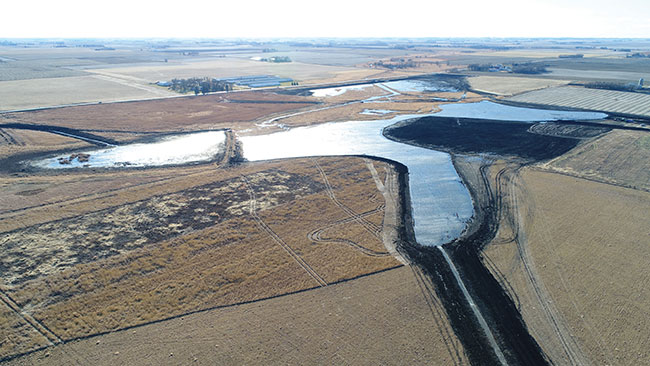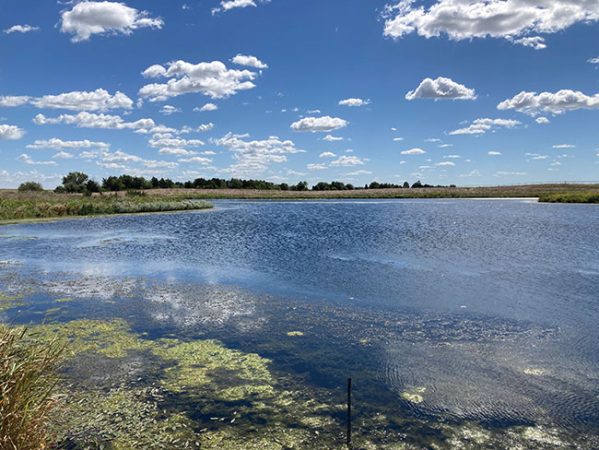
Features
Environment
Always mind your P and N
Checking in on Iowa's state-wide Nutrient Reduction Strategy
January 28, 2021 By Donna Fleury
 A restored wetland is an edge-of-field practice with great potential for nitrate-N reduction and water quality benefits.
Photo courtesy of the Iowa Department of Agriculture and Land Stewardship.
A restored wetland is an edge-of-field practice with great potential for nitrate-N reduction and water quality benefits.
Photo courtesy of the Iowa Department of Agriculture and Land Stewardship. Iowa began a renewed focus on nutrient reduction about 10 years ago, and in 2013 finalized the Iowa Nutrient Reduction Strategy (INRS).
State strategies to reduce nutrients were an outgrowth of the work of the Mississippi River/Gulf of Mexico Hypoxia Task Force. Co-chaired by the United States Environmental Protection Agency (EPA) and Iowa’s Department of Agriculture and Land Stewardship (IDALS), with representatives from 12 states, the task force developed a framework for states to begin to achieve nutrient reductions, with a goal of reducing nitrogen (N) and phosphorus (P) by 45 percent across the 1980-96 baseline.
“The Department of Natural Resources (DNR) was initially focused on what we had authorization to deal with, principally city and industrial wastewater treatment plants that discharge N and P,” explains Adam Schnieders, water quality resource coordinator with Iowa DNR. “Once the EPA finalized the nutrient reduction frameworks, leaders in the state of Iowa came together to build the INRS to achieve the reductions.”
The Iowa DNR combined their efforts and focus on point sources with the Iowa IDALS efforts focused on non-point sources and agriculture landscapes, and Iowa State University (ISU) took the lead on science coordination. The INRS is a science- and technology-based approach that outlines voluntary efforts to reduce nutrients in surface water from both point sources, such as wastewater treatment plants and industrial facilities, and nonpoint sources, including farm fields and urban areas, in a scientific, reasonable and cost effective manner.
“The task force members recognized the magnitude of the problem and each state has developed their own policies and programs to help achieve the goal of reducing the N and P load,” says Schnieders. “There are lots of different policy approaches being used to reduce nutrients across the country as every state is different, they have different landscapes and different balances between point source and nonpoint contributions to nutrients in surface water. We built policy around what actions we can take now to try to achieve these goals in Iowa. We recognize it is a significant long-term effort to get to the goals, but it is technically possible and implementation requires persistence.
“We are building on the legacy of the priorities focused on soil conservation over the last few decades and the significant improvements through documented shifts in conservation tillage, improved fertilizer management and structural practices to assist in reducing soil erosion and P losses to streams,” explains Matt Lechtenberg, water quality coordinator, Iowa IDALS. “Now under this new strategy, there is more of an emphasis on N and together with the introduction of new technology, there are greater opportunities to focus on reducing N losses. Although P losses are largely managed through practices that reduce soil erosion and surface runoff into streams, they are not solutions for N subsurface losses. Other in-field practices are needed for managing N such as cover crops, fine-tuning fertilizer application rates and timing, in combination with new edge-of-field technologies that intercept, capture and treat subsurface drainage water before it goes into Iowa rivers and streams such as saturated buffers, bioreactors, oxbows and wetlands.”
In August 2021, the INRS launched a new web-based dashboard that includes more visual reporting tools to improve the reporting process. Regular updates will focus on ‘measurable indicators of desirable change’ – inputs, human, land and water – that guide the Nutrient Reduction Strategy. A 2020 land update was included and shows some progress made toward the strategy goals. Along with increases in cover crops and no-till acreage that have reduced annual N and P losses, new edge-of-field installations include at least 27 bioreactors and 13 saturated buffers in Iowa. The report shows that 86 nitrate removal wetlands had been constructed with another 30 under development. (https://nrstracking.cals.iastate.edu/tracking-iowa-nutrient-reduction-strategy)
“The strategy has now been in place for a little over eight years and although getting practices implemented takes time, we are starting to see acceleration of projects,” says Matthew Helmers, director, Iowa Nutrient Research Center at ISU. “Although P has had a dedicated focus for the last 30 years, the focus on N reduction is more recent. Many of our N reduction practices are a bit newer and some of the technologies such as saturated buffers didn’t even exist in 2013. We are seeing continual new technology development and new methods for implementing practices, and there is real recognition that for us to make progress on reducing nitrate load we have to greatly accelerate the rate at which these practices are adopted. It is really important right now that the agriculture community and drainage contractor community be proactive about increasing the number of practices going in on the landscape.”
Helmers notes that the INRS includes a listing of practices, and it is important for farmers and contractors to look at the landscape and evaluate which practices might work best for individual field and farm situations. “The timelines for planning, design, approvals and implementation will vary depending on the practice and will take commitment from the farmer, contractor and engineer to see the process through. For example, saturated buffers or bioreactors may take six to 12 months, while a wetland may take 18 to 24 months because of some permitting requirements. For some practices, at least in Iowa, a professional engineer is required to design the practice. It is not just about money and practices, it is also the need to have appropriate human capital to scale up.”
Although many projects are initiated and implemented by individual farmers, the success of a recent larger scale, partnership model in Polk County could become a model for others. In this saturated buffer project, several urban and agriculture partners came together to tackle one larger project including several different farmers and field sites and one construction contract. “This is an innovative concept and took a lot of back and forth to develop a process to make this work through a variety of partners and landowners. This model has the potential to be much more efficient and streamlined compared to traditional processes,” says Lechtenberg. “The project added 40 saturated buffers and 11 bioreactors to farm fields, involving multiple landowners but only one contract for construction. A second phase for another 100 sites is being considered. This is a shift from our traditional process and allows us to align funding and push the envelope on certain projects to help increase the scale and pace of getting projects implemented.”

Wetlands is an edge-of-field practice show great potential for nitrate-N reduction and water quality benefits.
Photo Credit courtesy of Matthew Helmers.
What part can contractors play?
Drainage contractors are important partners in these projects. “There are lots of training opportunities to learn about these practices and design considerations in Iowa, across the midwest and into Canada,” says Helmers. “A number of drainage contractors have been very involved in helping install some of the processes in our research and we encourage others who are interested to contact their land grant university to learn more about the research and how they might lend their expertise.”
“With aging drainage infrastructure, contractors can consider opportunities to add edge-of-field practices to planned retiling projects,” says Schnieders. “There are several cost-share programs available for those practices to ensure that if new or replacement drainage work is occurring, additional practices are implemented to treat the water before it leaves the field and enters rivers and streams to achieve the water quality goals for local watersheds, the state and the Gulf.” Lechtenberg adds, “by aligning systems and programs, we can make it more streamlined to bolt-on an edge-of-field practice at the same time as a large tiling job is underway rather than coming back later. However, in some cases standalone bolt-on edge-of field practices may be the most practical.”
With more state and federal funding and new technologies and proven practices available, the INRS partners are reaching out to more farmers and contractors to ramp up the scale and pace of implementation and adoption to meet the N and P nutrient reductions.
Helmers and his team are leading research on these practices to prove their performance, solve challenges, find ways to increase performance and trial new technologies and practices as they are introduced. In some cases, partners support monitoring that helps with research and gives farmers and landowners the assurance the practice will do what it is expected to do.
“Some of the solutions do so much more than nutrient reductions, including bringing together partners from federal, state, county and city governments, farmers, clean water organizations and industry organizations,” says Schnieders. “For example, implementing a wetland project for nutrient reduction, depending on the design, can absorb and slow down water, help alleviate flooding, improve habitat for pollinators and wildlife, provide carbon benefits and protect drinking water sources. We recognize everyone wants this to go more quickly and it’s always great to hear from people who have ideas or want to talk about different approaches to keep things going. It is an exciting time and we now have the opportunity to accelerate the level of adoption to help meet the N and P nutrient reduction goals at that same time as bringing other benefits to water quality, the landscape and the environment.” DC
Print this page